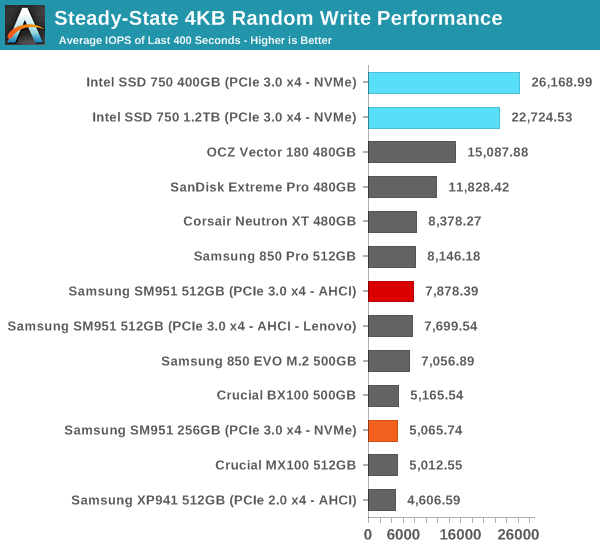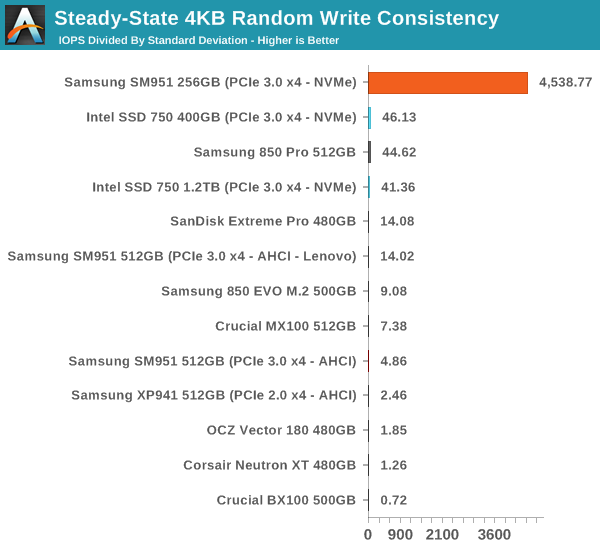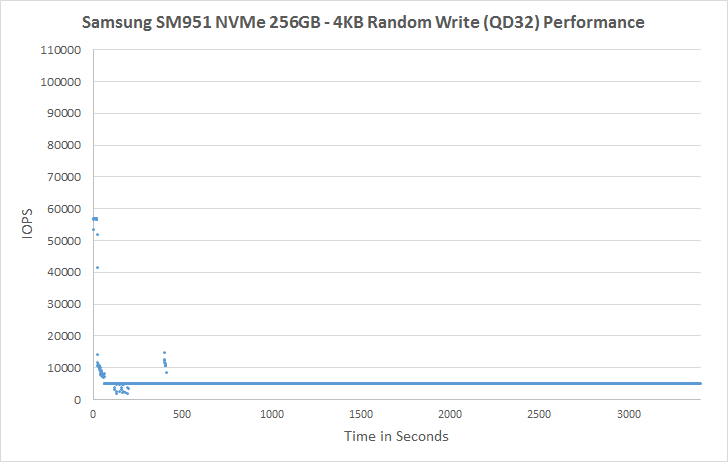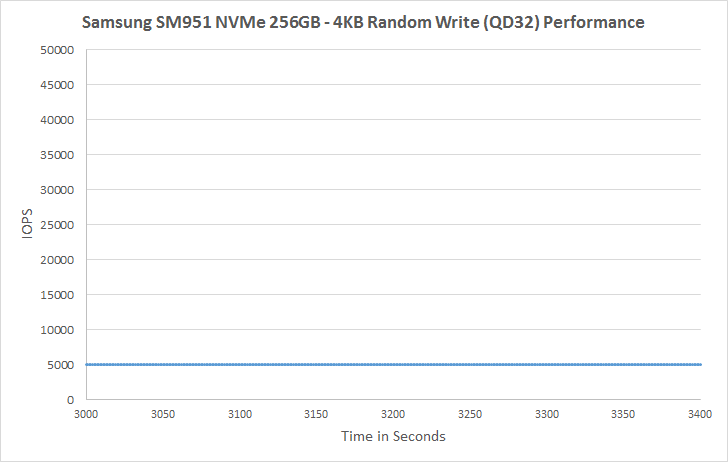Samsung SM951-NVMe (256GB) PCIe SSD Review
by Kristian Vättö on June 25, 2015 9:40 AM ESTPerformance Consistency
We've been looking at performance consistency since the Intel SSD DC S3700 review in late 2012 and it has become one of the cornerstones of our SSD reviews. Back in the days many SSD vendors were only focusing on high peak performance, which unfortunately came at the cost of sustained performance. In other words, the drives would push high IOPS in certain synthetic scenarios to provide nice marketing numbers, but as soon as you pushed the drive for more than a few minutes you could easily run into hiccups caused by poor performance consistency.
Once we started exploring IO consistency, nearly all SSD manufacturers made a move to improve consistency and for the 2015 suite, I haven't made any significant changes to the methodology we use to test IO consistency. The biggest change is the move from VDBench to Iometer 1.1.0 as the benchmarking software and I've also extended the test from 2000 seconds to a full hour to ensure that all drives hit steady-state during the test.
For better readability, I now provide bar graphs with the first one being an average IOPS of the last 400 seconds and the second graph displaying the standard deviation during the same period. Average IOPS provides a quick look into overall performance, but it can easily hide bad consistency, so looking at standard deviation is necessary for a complete look into consistency.
I'm still providing the same scatter graphs too, of course. However, I decided to dump the logarithmic graphs and go linear-only since logarithmic graphs aren't as accurate and can be hard to interpret for those who aren't familiar with them. I provide two graphs: one that includes the whole duration of the test and another that focuses on the last 400 seconds of the test to get a better scope into steady-state performance.

Steady-state performance isn't mind blowing, although it's a little unfair to compare the 256GB SM951-NVMe against a 512GB SM951-AHCI because available NAND throughput can play a major role in steady-state performance with a properly designed controller and firmware.

The mediocre steady-state performance is replaced by outstanding consistency, though. During the last 400 seconds, the SM951-NVMe has standard deviation of only 1.12, whereas the next drives are in the order of hundreds with many drives surpassing 1,000.
 |
|||||||||
| Default | |||||||||
As there's practically no variation in performance, the graph is just a straight line after the initial cliff. There are zero up and down swings, which is something I've yet to see even in an enterprise SSD. Samsung has always done well in IO consistency, but in all honesty the SM951-NVMe sets a new bar for consistency. On the downside, I would rather take some variation with higher performance because especially for client workloads such level of consistency isn't really needed, but increased performance can always help with intensive IO workloads. Nevertheless, I'm very happy with the direction Samsung is taking because we still see some controller vendors not paying enough attention to consistency, but it's clearly a high priority for Samsung.
Unfortunately I couldn't run any tests with added over-provisioning because the hdparm commands I use for limiting the capacity do not work with NVMe drives. There are similar commands for NVMe drives too, but for now there is no publicly available utility for issuing those commands.
 |
|||||||||
| Default | |||||||||










74 Comments
View All Comments
patrickjp93 - Thursday, June 25, 2015 - link
They aren't all storage transfer commands go through the PCH. Your PCIe SSDs do not connect to the CPU directly in most cases. Some enterprise grade drives do, but most consumer do not.Kristian Vättö - Friday, June 26, 2015 - link
PCIe is PCIe regardless of whether the controller is inside the CPU or PCH. PCH merely acts as a hub for different interfaces, but ultimately it connects to the CPU as well since that is where all the processing is done.CajunArson - Thursday, June 25, 2015 - link
Yeah so are we missing some sound and FURY [hint hint] about this SSD on a stick?Kristian Vättö - Thursday, June 25, 2015 - link
Fury X is coming, Ryan just needed one more day because the flu has been undermining his ability to work.DigitalFreak - Thursday, June 25, 2015 - link
(hint hint) The 980ti is faster than the Fury X all around.CajunArson - Thursday, June 25, 2015 - link
I'm not disagreeing with that statement.I just want the review.
lilmoe - Thursday, June 25, 2015 - link
+1A DX12 showdown between FuryX and 980ti would be highly welcome as well.
Gigaplex - Thursday, June 25, 2015 - link
The Fury X wins in some of the 4k tests. The 980Ti seems faster overall, but it's not "all around".mr_tawan - Friday, June 26, 2015 - link
From what I've read, it looks like the Fury has advantages when it comes to memory-intensive use case.SofS - Thursday, June 25, 2015 - link
About the driver issue, how do different operating systems fare? Like 32/64 bits, XP/7/8/10 and Linux old/new (for instance CentOS/Fedora).